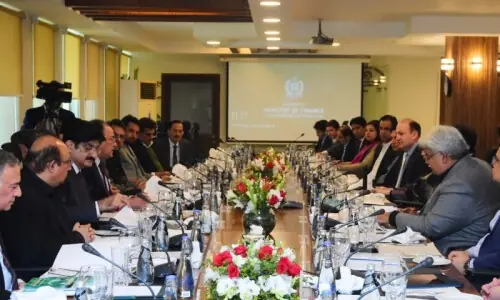The current climate-induced devastating torrential monsoon rains and floods have taken a heavy toll on human lives, destroyed property, roads, bridges, schools, health units and submerged farmland and villages under water resulting in huge crops and livestock losses.
With farm-to-market roads and highways damaged and the transport system disrupted, and millions of farmers in extreme distress, the calamity has further fueled inflation and enhanced food insecurity.
Prime Minister Shahbaz Sharif said on August 30 that torrential rains and floods have submerged one-third of Pakistan and 33 million people have been affected.
The loss of farm output and livestock may lead to lower exports, higher imports, widening current account deficit and slower economic growth. The rural areas provide a big market for industrial goods while agriculture provides raw materials for the export-oriented manufacturing sector.
Mini dams conserve rainwater, reduce poverty and are affordable compared to mega projects
First of all, the situation demands that both the federal and provincial governments should rescue affected people, provide relief and rehabilitate flood victims. This has to be followed up by repairs to the damaged infrastructure.
While making an appeal to the international community for donations, Prime Minister Sharif said it would cost at least $10 billion to repair damaged infrastructure and provide aid to those affected by rains and floods. Referring to global climate changes, the United Nations Resident Coordinator in Pakistan Julian Harneis reminded donors that the devastation is ‘internationally-driven.’
Taking a medium- and long-term view, there are many preventive measures to avoid the impact of floods such as the use of early preventive warning devices, restoring rivers, cleaning drainage, erecting flood barriers etc. But no less importance should be accorded to the construction of a network of small, mini dams in the country’s rain-fed areas.
There is a lot of official focus on building mega-dams without any meaningful progress because of multiple problems including financing. Of course, the need for large dams for sustainable agriculture cannot be denied.
On the other hand, small dams could be erected with domestic resources and local talents and skills at a fractional cost of large ones and at a faster pace to conserve rain and flood waters for irrigation, electricity generation and supply of drinking water.
The construction of small dams has never been a priority of successive governments though the country has the required expertise in building dams.
Small storage dams can play a key role in promoting agriculture, placing the maximum area under cultivation, and bringing in a ‘green revolution’ within a short span of time, said a study carried out a decade and a half ago. Small dams also have a positive impact on groundwater development.
In fact, small dams are considered more suitable for Pakistan by experts as they are stated to have proven an effective tool for poverty alleviation. They bring immediate economic prosperity at a local level.
Way back in May 2008, a National Engineering Services Pakistan expert quoted a credible study which had then estimated that Pakistan had the potential to build some 750 small dams to meet the water requirements of the growing local and regional population. At that time the country reportedly had merely 56 dams, against 12,000 in Sri Lanka, more than 2,000 in Nepal and 19,134 in India.
Various studies conducted in 2019 in the Pothwar Plateau, Punjab, established that around 11,000m cubic of water is lost annually due to surface run-off in rain-fed areas. If 50 per cent of this run-off is conserved in small or mini-dams, then half the water-storage capacity of Tarbela Dam (the largest one in Pakistan) could be retained. By 2017, 50 small dams had been built and another eight were under construction in the region.
Unfortunately, issues are allowed to linger on to become big problems, finally turning into serious crises. And most of the time the governments are trapped in firefighting and have little time and resources to spare for long-term solutions. This is what is happening now in the aftermath of climate change. that includes the floods of 2010.
Although no creditable figure for the total number of small dams is immediately available, one can see the pace of progress in this sector through recent official announcements and media reports.
Provincial Irrigation Minister Jam Khan Soro informed the Sindh Assembly on August 3 that 116 small dams have been constructed in the province and work is going on another 64 small dams, which are due to be completed by next year.
On February 6, Punjab Small Dams Organisation approved the construction of nine new dams in the Rawalpindi Division and Islamabad. A sum of Rs24.87m was allocated for topographic surveys for these dams.
PTI Chairman Imran Khan announced on August 26 that 10 more dams would be built in Khyber Pakhtunkhwa to avoid recurring devastations such as caused by the ongoing super deluge in the province.
Earlier KP Minister for Irrigation Arshad Ayub Khan had said construction work had been initiated on seven small irrigation dams and water reservoirs in the newly merged districts in the province. These dams, estimated to cost Rs9bn, would irrigate 14,135 acres of barren land.
Some 25 small dams were stated to have been completed in different areas in KP to store flood and rainwater during monsoon for irrigation and drinking purposes by July 2019, nine of them from 2002 to 2019.
Baluchistan had built 64 small dams in rain-fed areas by March 31 under a phased federal programme of 100 small dams that are expected to be completed by 2026, according to provincial authorities. The 64 dams irrigate 25,850 acres of land.
Given the current state of governance and service delivery, both the federal and provincial governments need to ensure that small dams are constructed as scheduled without delays. And planning should also be initiated to realise the country’s full potential for the construction of mini and small dams on a priority basis to store rainwater, improve people’s livelihoods and avoid a catastrophe on a scale being witnessed now.
Published in Dawn, The Business and Finance Weekly, September 5th, 2022































